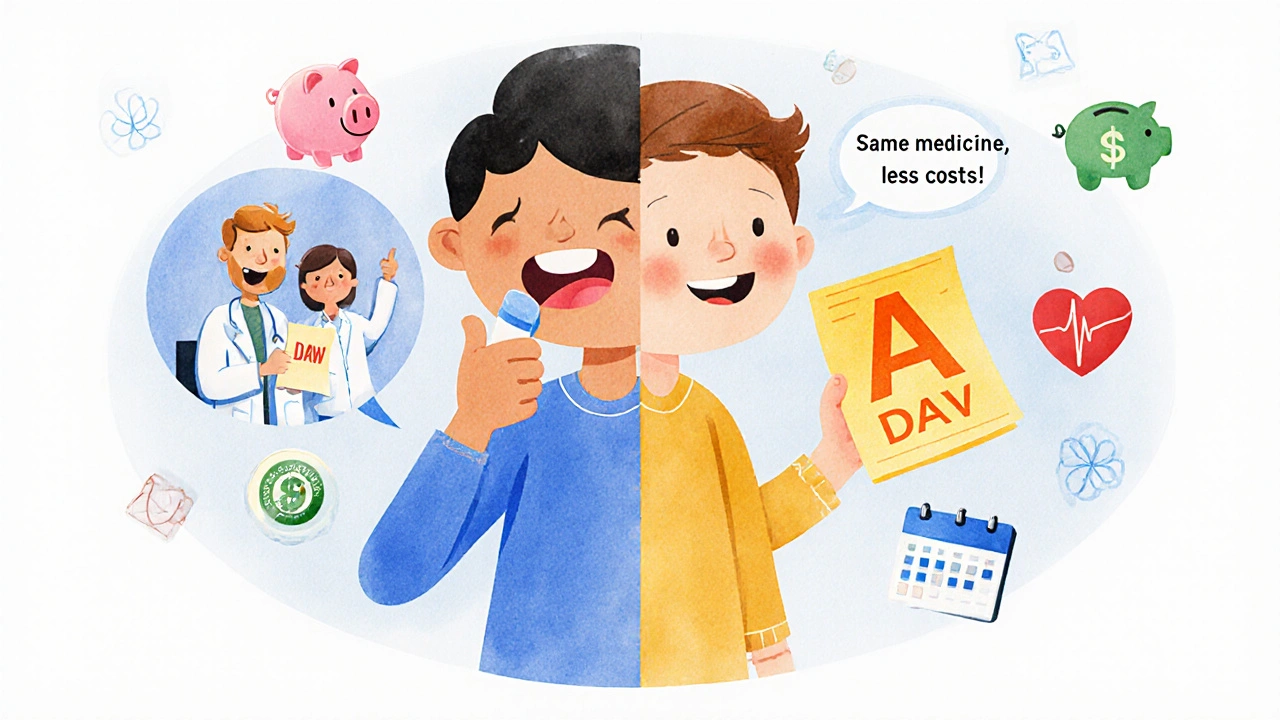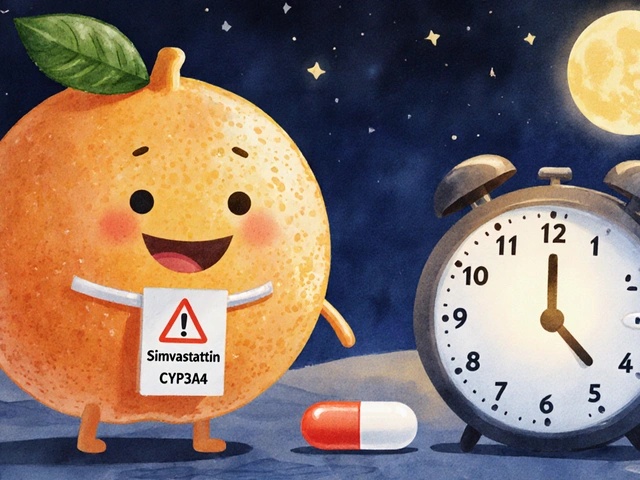When a pharmacist hands you a generic pill instead of the brand-name drug your doctor prescribed, it’s not just a cost-saving trick. It’s a clinical decision - and one that requires clear, confident communication with the prescriber. In 2025, over 97% of prescriptions filled in the U.S. are for generic drugs, saving the system more than $400 billion a year. But behind every generic substitution is a conversation that often never happens - or happens poorly.
Why Pharmacists Recommend Generics
Pharmacists don’t recommend generics just because they’re cheaper. They recommend them because they work. The FDA requires generic drugs to have the same active ingredient, strength, dosage form, and route of administration as the brand-name version. More importantly, they must pass strict bioequivalence testing. That means the amount of drug absorbed into your bloodstream must fall within 80% to 125% of the brand-name product. In reality, 98.7% of approved generics stay within 95% to 105%, making them nearly identical in how your body handles them. A 2018 study tracking 12.7 million patients found that switching to generics improved medication adherence by 12.4%. That’s not a small number. For someone with high blood pressure or diabetes, better adherence means fewer hospital visits, fewer complications, and lower long-term costs. Pharmacists see this every day. When patients can’t afford their meds, they skip doses. Generics fix that.The Orange Book: The Pharmacist’s Secret Weapon
The key tool pharmacists use to justify a generic recommendation isn’t a sales pitch - it’s the FDA’s Orange Book. Officially called Approved Drug Products with Therapeutic Equivalence Evaluations, it’s updated every month and lists every approved generic with a rating: 'A' means therapeutically equivalent. 'B' means it’s not. Over 92% of generics carry an 'A' rating. When a pharmacist sees a prescription for a brand-name drug like Lipitor, they check the Orange Book. If a generic with an 'A' rating is available, they can legally substitute it - unless the prescriber wrote 'dispense as written' (DAW). About 15% of prescriptions have DAW on them. Some are valid. Some are just habit. That’s where the conversation starts. A pharmacist doesn’t just call and say, “Can I switch this?” They say, “The generic for atorvastatin has an A rating in the Orange Book. Bioequivalence data shows no clinically meaningful difference. The cost difference is $42 per month. Would you like me to proceed?” That kind of specificity changes minds.When Substitution Isn’t Allowed - And Why
Not all drugs are created equal. Some have a narrow therapeutic index (NTI), meaning the difference between a dose that works and one that’s toxic is tiny. Warfarin, levothyroxine, and phenytoin fall into this category. Even small differences in absorption can cause serious problems. The FDA has issued only 12 product-specific guidances out of over 1,400 that address NTI drugs. That’s because substitution here isn’t about cost - it’s about safety. Pharmacists are trained to flag these. If a patient is stable on brand-name Synthroid, a pharmacist won’t switch them to a generic without checking with the prescriber - even if the Orange Book says it’s 'A' rated. Another reason to hold off? Inactive ingredients. Generics can have different fillers, dyes, or preservatives. For 8.7% of patients with allergies or sensitivities, that matters. One patient might react to the dye in a generic version of gabapentin, while another has no issue. Pharmacists track these cases. If a patient reports a reaction after switching, the pharmacist contacts the prescriber immediately.How Pharmacists Get Prescribers to Say Yes
Prescribers aren’t always on board. A 2023 survey found that 37.6% of doctors still worry generics aren’t as effective - especially for inhalers, topical creams, or complex formulations. That’s not because the science is weak. It’s because they don’t see the data. The most effective pharmacists don’t argue. They provide evidence. They send a note via the EHR saying: “Generic atorvastatin 20mg, A-rated, NDC 00001-2345-01, manufacturer Teva. Cost: $5 vs. $47. Bioequivalence range: 98% AUC, 102% Cmax. Patient adherence improved 12% in similar cases.” A 2021 study showed that when pharmacists used this structured approach, prescribers accepted the switch 82% of the time. Without it? Only 57%. The difference isn’t just technique - it’s respect. Pharmacists who cite the FDA, cite the Orange Book, cite real data, are treated as partners. Those who say, “It’s cheaper,” get ignored.Technology Is Changing the Game
In 2025, 87% of prescribers use electronic systems like Surescripts that integrate generic substitution alerts directly into their workflow. When a pharmacist selects a generic, the system sends a pre-filled message to the prescriber’s inbox: “Substituted generic for lisinopril. Orange Book A-rated. Cost saved: $38/month. Patient has 3 chronic conditions.” That cuts communication time from 8 minutes to under 3 minutes. And it makes documentation foolproof. The Centers for Medicare & Medicaid Services (CMS) now audits pharmacies for documentation completeness. Pharmacies using EHR-integrated tools hit 95% compliance. Those using paper logs? Barely 76%. Even AI is stepping in. Tools like PharmAI’s Generic Substitution Assistant analyze patient history, drug interactions, and formulary rules to suggest the best generic option - and even draft the communication to the prescriber. Adoption is growing fast. Chain pharmacies using AI saw recommendation accuracy jump from 76% to 94% in 2023.
What Happens When Communication Fails
When pharmacists don’t communicate - or when prescribers ignore them - the consequences show up in the data. A 2023 study of 4,521 pharmacies found that those with poor documentation had 27.5% more medication errors related to substitution. Patients got the wrong dose. The wrong manufacturer. The wrong formulation. Some ended up in the ER. Worse, patients lose trust. If they’re switched to a generic without explanation, they assume it’s “inferior.” They stop taking it. They blame the pharmacist. They blame the doctor. That’s why transparency matters. The American Medical Association and American Pharmacists Association agree: every substitution should be documented with the date, method, prescriber name, rationale, and outcome.What’s Changing in 2025
The Inflation Reduction Act, which took effect in January 2025, expanded Medicare Part D’s medication therapy management (MTM) services. Now, pharmacists can bill for proactive generic optimization - meaning they’re paid to call prescribers, review med regimens, and recommend cost-effective switches. That’s a game-changer. For the first time, pharmacists aren’t just dispensers. They’re part of the care team. And with 21.3 million Medicare beneficiaries affected, the volume of these conversations is exploding. The FDA is also updating the Orange Book in late 2024 to include real-world evidence - not just lab data. That means if a generic version of a drug has been used safely by 500,000 patients over two years, that data will be added to its rating. No more guesswork.What Pharmacists Need to Know
You don’t need to memorize every Orange Book rating. But you do need to know how to find them - fast. You need to know which drugs are NTI. You need to know which states require patient consent before substitution (17 states do). You need to know how to document everything. Most of all, you need to know that your voice matters. Prescribers don’t always know what’s in the Orange Book. They don’t always know how much a generic saves. They don’t always know how adherence improves with cost reduction. Your job isn’t to replace the doctor. It’s to support them - with facts, with data, and with confidence.Can pharmacists substitute generics without asking the prescriber?
Yes - in 49 states, pharmacists can substitute a generic if it’s rated therapeutically equivalent (‘A’ rating in the FDA’s Orange Book) and the prescriber hasn’t written ‘dispense as written’ (DAW). However, 17 states require patient consent before substitution, and 5 states limit substitution to only those generics listed in their state formulary. Always check your state’s pharmacy board rules.
Are generic drugs really as effective as brand-name drugs?
Yes. The FDA requires generics to meet the same strict standards for quality, strength, purity, and stability as brand-name drugs. Bioequivalence testing ensures the amount of active drug absorbed into the bloodstream is nearly identical - typically within 95% to 105% of the brand. A 2018 study of 12.7 million patients found no difference in clinical outcomes between generics and brands for most conditions.
Why do some prescribers refuse generic substitutions?
Some prescribers have concerns based on outdated beliefs, anecdotal experiences, or lack of exposure to bioequivalence data. Common reasons include fear of reduced efficacy for complex drugs like inhalers or topical creams, concern about patient response changes, or simply not knowing the generic is equivalent. Pharmacists can overcome this by providing specific data from the FDA’s Orange Book and Product-Specific Guidances.
What should I do if a patient has a reaction after switching to a generic?
First, document the reaction - including symptoms, timing, and the specific generic product dispensed. Then, contact the prescriber immediately with the National Drug Code (NDC) and manufacturer. Inactive ingredients (fillers, dyes, preservatives) in generics can differ from brands and may trigger allergies in 8.7% of patients. If needed, return the patient to the original brand or switch to a different generic with a different formulation.
How do I know if a generic is truly equivalent?
Check the FDA’s Orange Book. Look for the ‘A’ rating next to the generic product. This means it’s therapeutically equivalent to the brand. Avoid generics with ‘B’ ratings - they are not considered interchangeable. For high-risk drugs like warfarin or levothyroxine, also review the FDA’s Product-Specific Guidances, which may recommend caution even with ‘A’-rated products.
Is it safe to switch a patient from brand to generic for a chronic condition?
Yes - and it’s often beneficial. Studies show patients on generics for chronic conditions like hypertension, diabetes, and high cholesterol have better adherence and fewer hospitalizations. The key is communication: inform the patient why you’re switching, document the change, and monitor for any adverse effects. For narrow therapeutic index drugs, consult the prescriber before switching, even if the Orange Book says it’s safe.





11 Comments
Jennifer Shannon
It’s fascinating, really-how something as simple as a pill swap can ripple through an entire healthcare system, like a pebble dropped in a pond. I’ve seen friends switch to generics and suddenly afford their insulin, their blood pressure meds, their antidepressants… and not just afford them, but take them consistently. It’s not just chemistry-it’s dignity. And yet, we still treat pharmacists like clerks instead of clinicians. They’re the ones holding the Orange Book like a sacred text, cross-referencing bioequivalence data, knowing which fillers trigger allergies, and quietly fixing gaps in care that doctors don’t even see. I wish more people realized: the person handing you your meds might be the most important person in your treatment plan today.
Dalton Adams
Let’s be clear-this is all just marketing dressed up as science. The FDA’s ‘bioequivalence’ standards are laughably loose. 80–125%? That’s a 45% window! If I told my accountant to deliver my taxes within ±45% of the correct amount, I’d be fired. And don’t get me started on ‘A’ ratings-some generics have the same active ingredient but different excipients that alter absorption kinetics in unpredictable ways. The data? Cherry-picked. The studies? Funded by generics manufacturers. And don’t even mention AI tools-now we’re outsourcing clinical judgment to algorithms trained on corporate datasets. 🤦♂️
Kane Ren
Love this breakdown. Seriously. So many people think generics are ‘cheap knockoffs’-but they’re not. They’re the same medicine, just without the fancy packaging and ad campaigns. And the fact that adherence improves? That’s the real win. More people taking their meds = fewer ER visits = less stress for everyone. Keep doing the work, pharmacists. You’re heroes.
John Mackaill
I’ve worked in UK community pharmacies for 18 years, and this is exactly what we’ve been doing here since the 90s. The Orange Book? We have the Yellow Card system and the BNF. Same principles. But what’s different here is how much you’re documenting, how much you’re collaborating. In the UK, we’re still fighting to be seen as part of the clinical team-not just dispensers. I’m impressed by how data-driven your approach is. Maybe we need to borrow your EHR integration model. It’s not about cost-it’s about care.
Casper van Hoof
It is a matter of epistemological clarity that the substitution of pharmaceuticals, particularly within the context of therapeutic equivalence, necessitates a rigorous ontological framework predicated upon empirical verification and regulatory orthodoxy. The FDA’s Orange Book, as a codified epistemic artifact, functions as a discursive apparatus through which pharmacological legitimacy is negotiated and institutionalized. To reduce this complex hermeneutic process to mere cost-efficiency is to commit a category error of the highest order.
Richard Wöhrl
Just wanted to add something important-when a patient reports a reaction after switching, it’s not always the generic’s fault. Sometimes, it’s the *new* manufacturer’s filler. One guy I worked with had a severe rash after switching from one generic levothyroxine to another-same active ingredient, same rating. Turned out, it was the dye in the new version. We called the prescriber, switched him back, and flagged the NDC in his chart. That’s the kind of detail that saves lives. And yes, pharmacists *do* remember these things. We track them. We log them. We follow up. It’s not just paperwork-it’s personal.
Pramod Kumar
Man, this hits home. In India, generics are the only option for most people. We call them 'jugaad' medicines-clever, makeshift, but lifesaving. But here’s the twist: even in places with no fancy EHRs, pharmacists still know which brand does what. We’ve got our own ‘Orange Book’-oral history passed down from senior pharmacists. ‘Don’t use the red one for diabetics, it’s got too much sugar.’ ‘That blue one? It’s good for asthma, but the pills are too big for kids.’ We don’t need AI to tell us what works-we’ve seen it. And you know what? Patients trust us because we’ve been there, every day, watching them take their pills, asking how they feel. That’s the real data.
Brandy Walley
Generic drugs are just corporate fraud. They make you sick. I know because I took one and got dizzy. Doctors know this. They just don't care because they get kickbacks. Pharmacies are just profit mills. Stop lying.
shreyas yashas
My uncle’s on warfarin. Switched him to generic once-big mistake. INR went wild. We went back to brand. No argument. No data. Just… don’t mess with it. Pharmacists know this stuff. But sometimes, even with an ‘A’ rating, you gotta listen to the patient. Real life isn’t in the Orange Book. It’s in the kitchen, at 3 a.m., when someone’s sweating and scared because their pill looks different.
Suresh Ramaiyan
This whole system reminds me of how we handle tea in India. You’ve got Darjeeling, Assam, Chai-same plant, different soil, different brew. But if you tell someone, ‘This is just tea,’ they’ll think you’re crazy. The brand matters because of trust, not chemistry. Same here. People aren’t rejecting generics because they’re dumb-they’re scared. The job isn’t to prove they’re equal. It’s to help them feel safe. That’s why the pharmacist’s voice, calm and clear, with the Orange Book in hand? That’s the magic. Not the cost. Not the algorithm. The human.
Katy Bell
I’m a nurse. I’ve watched patients cry because they couldn’t afford their meds. Then they got the generic… and they smiled for the first time in months. I’ve seen doctors roll their eyes when pharmacists suggest switches. But then, one day, a pharmacist walked in with a printed chart-bioequivalence numbers, cost savings, adherence stats-and the doctor just… nodded. No argument. Just, ‘Okay.’ That’s when I knew: it’s not about who’s right. It’s about who’s listening. And pharmacists? They’re the quiet ones who’ve been listening all along.